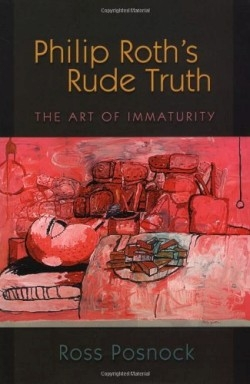Philip Roth's Rude Truth
The Art of Immaturity
“What wisteria and alcohol are to Faulkner, and fishing and bullfights to Hemingway, rudeness is to Roth,” writes the author. “It seems to be everywhere in his books—a sport and a pastime, often delivered as a rant. Rudeness in Roth is a source of stylistic energy, but also a principled (even moral) position, the antidote to the condition of ‘anti-humanity that calls itself nice.’”
In this complex and stimulating book, Posnock, professor of English at Columbia University, rethinks the career of American novelist Philip Roth. Posnock, who has written books about William James and Ralph Ellison, examines an original premise—that rather than being a provocateur and a regional Jewish-American writer of some significance, Roth represents a line of American authors descended from Melville, Emerson, and James. The core of this premise is the observation that immaturity, or rudeness, is a means of avoiding the generic “niceness” of the American middle class. This liberation from the consistency of maturity allowed Roth to reveal truth, and reveal it in a manner that resonated with an alienated youth culture uninterested in avoiding unpleasantness.
Posnock places Roth within a cosmopolitan community of authors ranging from Melville to Salinger who have rejected the separation of mind and body in favor of an aesthetic that rejects the very idea of knowing oneself. Roth sees the world as a place in which people are inconsistent, rude, ruthless, self-destructive, and above all, human. One of the most interesting themes in this fascinating work is Posnock’s understanding of immaturity as a reaction to control, an idea that explains the numerous links between Roth’s examination of undemocratic trends in America, and Eastern European authors’ reactions to totalitarianism.
The book is organized both by theme and by specific references. There are seven chapters and a brief “Coda.” The first three chapters sketch out the main book’s themes: an introduction, a history of aesthetic immaturity, and the ideas of appropriation and assimilation in Roth. Later chapters look at examples from specific works, and chapter seven examines the relationship between Roth and his friend, the painter Philip Guston.
Posnock has written an excellent book of criticism, exploring not just Roth, but also literature that emerged mid-century with roots in a long tradition of American and European art. One doesn’t need to be familiar with Roth’s novels to appreciate this book, but it will particularly appeal to anyone who knows at least some of Roth’s novels and illuminates in direct proportion to familiarity with his artistic world.
Disclosure: This article is not an endorsement, but a review. The publisher of this book provided free copies of the book to have their book reviewed by a professional reviewer. No fee was paid by the publisher for this review. Foreword Reviews only recommends books that we love. Foreword Magazine, Inc. is disclosing this in accordance with the Federal Trade Commission’s 16 CFR, Part 255.

